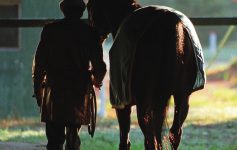Every now and then, someone writes a book that I love.
Less-often, someone pens a tome to which I can relate, directly, and cry my way through to the end.
“Flying Change: A Year of Racing and Family and Steeplechasing” by Patrick Smithwick is one of those books.
This is a tale that speaks to my heart, because only nine years ago, did I find and embrace my own vocation–the reason I was put on this planet. I was 47 at the time, and felt too old to do a turnaround.
Perhaps you understand how I felt? Maybe you’re feeling that way right now? I urge you to read this book review–better yet, buy the book–if you’re over 40 and feel the urge to embrace the next part of your Life, full-throttle.
I urge you to buy the book, also, if you’re over 40 and are terrified of exploring the options.
And I strongly encourage you to read the review–and yes, buy the book–if you’re under 40, and think that you have Life all figured out. You’re just young enough (and therefore, arrogant enough) to think that things are cast in stone, and you’re content.
Read on, O Friends, for–as we who are over 40 know–Life is never cast in stone. Life throws a curve ball at you, and you have two options: duck, and live, or get smacked in the bean…
I thought I was too old to embrace my vocation back in 2003.
My vocation, simply, is that I write about horses and racing.
I was 47, and 47 is weird: too young to collect Social Security, but too old to date 20-something boys. (Sob, on both counts.)
Not unlike teenagehood, the mid-40s should be understood by social psychologists as an “awkward age.”
Too tall for the kiddies’ rides, still too short to box with God.
I wrestled with the revelation that I should start horse writing–believing that no one would “have me,” because I was ancient.
And then someone reminded me that Grandma Moses was 85 when she started to paint–and that Penny Chenery was in her 50s when she took Riva Ridge and Secretariat to fame.
Well, Patrick Smithwick was one year older than I when he gave in to his passion, and got back in the sport of Steeplechase.
The son of the renowned A.P. Smithwick–yes, that A.P. Smithwick, for whom the A.P. Smithwick Memorial Steeplechase is named–Patrick grew up in a saddle, probably foaled in a stall.
He lived and breathed horses until he was 23, then retired from the sport. He had responsibilities to acknowledge and fulfill–and he was nothing, if not a responsible man.
The author holds several degrees, and he loves language and literature. It was natural, then, for him to teach at both the high school and college levels, helping others find their Muse and retain her services. No doubt his 25 years away from riding and training horses were good years–he had his words, his writing, his students, his children, wife and family Life. His relationship with his children was–is–warm and genuine. (Unlike so many others of whom we hear every day: have you ever heard of a reality show about a family who’s not dysfunctional?)
We’re just not used to reading or hearing about a good family, but that’s where Patrick Smithwick invested his heart, his time and his energy.
He’d done all the responsible things that a man with a wife and children “should” do: he was a newspaper editor, and Enlgish/literature teacher, among other things. He used his huge intellect and advanced degrees to establish himself in the literary world.
No doubt, he was a good provider.
But his heart told him that it was time to get back in the saddle. Literally.
Steeplechasing was in his blood, and I suspect that, had he not jumped back into the fray, a transfusion would have been in order. Once a sport, a horse, a passion–The Grand Passion, as I think of it–is nestled within, it does no good to try to exorcise it.
This passion was buried deep in his soul. Niggling away at him, like a chigger on the leg, it would not let go. He loved horses, he loved racing–in his heart, he’d always be a rider and trainer.
So, after 25 years of terribly responsible living, he decided at age 48 to train his body again, and within the space of nine months to ride in the most demanding Steeplechase race in the world.
He must have been insane.
Just to be sure you got that straight, I’ll repeat it: the author had been retired from the equine world for a quarter-of-a-century, when his soul told him NOT to ease his way back into it–but to train like a fiend, and to ride, in the most challenging Steeplechase race on Earth.
If he weren’t a horseman, he’d have been committed. But being a racetracker–well, we’re all nuts, so to me this decision of the heart makes perfect sense.
I’m not going to tell you the story–sorry, you must read this for yourself. I couldn’t tell the story as well as Smithwick, anyway–it’s his story, so you must experience it in the first person.
I’ll share a couple of little things, though:
For those of you who are Saratoga locals or race fans who love Saratoga–dig right in. The first 122 pages or so take place in Saratoga or the nearby Adirondacks. His brilliant use of language will bring you right back to the place, even if you haven’t been to Saratoga in 25 years. As both a horseman and a gifted writer, his use of words thrills me: his descriptions are so vivid, so clear, accurate and loving, that you’ll experience Saratoga as perhaps you’ve never known it before.
And I just must say here, that I fell in love with Smithwick’s intimate self-portrait the instant I saw that he’d quoted the first 10 lines of Chaucer’s Canterbury Tales. I have a weird thing for Middle English, the language in which Chaucer wrote: I fell in love with a man in the 1990s because he quoted the first, what, 27 lines?–of the poem, in Middle English. That’s it, I was done. And just this summer, I learned that Richard M. Holmes (Prof), my high school English teacher–could do the same.
Good thing I didn’t know that Prof had that talent, back in 1973.
To read, right away, that Patrick Smithwick prefaced his tale of the journey of his soul–with this piece of literature that means so much to me, on so many levels–blew my mind.
This is not a book ghostwritten by a “real” writer.
This is not an “as told to” story.
This is the journey of a single soul–a soul whose path affected those of everyone who loved him–and yet, he had to take that journey alone.
Those closest to him could cheer him on, encourage him and love him–but in the final analysis, this was a solo trip around the oval. And only he could write the book about this intimate ride from himself, to that place of being MORE of himself.
Buy this book. Read this book. Laugh, cry, experience this book.
But whatever you do, do not forget that this story is a challenge, to you, as well.
If you’ve already found your bliss–good for you.
If you’re just barely living–getting by, slogging through Life on your way to Death–please read this book as a How To. How To challenge yourself. Where to find your resources for refreshment, encouragement and love.
Whatever you do, never, never, never give up.
Winston Churchill said that, and Patrick Smithwick repeated the wisdom on page 321.
Wisdom–like Life, Love and God–is eternal.
Saratoga Signings:
Patrick Smithwick will sign copies of his book at the
National Museum of Racing and Hall of Fame on Wednesday, August 1, from 10AM – 1PM
and at
Saratoga Saddlery on Friday, August 3 from 5PM – 7PM.
(I’m sure that you may be able to buy copies of his previous book, Racing My Father, and get them signed, as well.)
Flying Change, A Year of Racing and Family and Steeplechasing
(Chesapeake Book Company, 342 pages, $30). ISBN: 978-0-9823049-4-5



